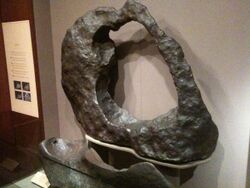Astronomy:Tucson Ring meteorite
From HandWiki
Short description: Iron meteorite found in Arizona, United States
| Tucson Ring | |
|---|---|
 The Tucson Ring meteorite on display at the Smithsonian Museum of Natural History | |
| Type | Iron[1] |
| Class | Iron, ungrouped[1] |
| Country | United States [1] |
| Region | Arizona[1] |
| Coordinates | [ ⚑ ] : 31°51′N 110°58′W / 31.85°N 110.967°W[1] |
| Observed fall | No |
| Found date | 1850[1] |
| TKW | 975 kg[1] |
The Tucson Ring meteorite is a brezinaite meteorite fragment, first described by Bunch and Fuchs.[2] It was reported as one of several masses of virgin iron found at the foot of the Sierra de la Madera and transported to the plaza of Tucson, Arizona circa 1850, where it was used as an anvil in a blacksmith's shop.[3]
References
- ↑ 1.0 1.1 1.2 1.3 1.4 1.5 1.6 "Tucson". https://www.lpi.usra.edu/meteor/metbull.php?code=24061.
- ↑ Anthony, John W.; Williams, Sidney A.; Bideaux, Richard A.; Grant, Raymond W. (2016-05-26) (in en). Mineralogy of Arizona. University of Arizona Press. ISBN 9780816534043. https://books.google.com/books?id=16JcCwAAQBAJ&dq=Tucson+ring+meteorite&pg=PA52.
- ↑ Clarke, Roy S. Jr.; Plotkin, Howard; McCoy, Timothy (2006), "Meteorites and the Smithsonian Institution", in McCall, G. J. H.; Bowden, A. J.; Bowden, R. J., The History of Meteoritics and Key Meteorite Collections: Fireballs, Falls and Finds, London: The Geological Society, p. 241, ISBN 9781862391949, https://books.google.com/books?id=7SvtVoa1W-cC&dq=nogata+meteorite&pg=PA16
 |


